Airbus A318
| A318 | |
|---|---|
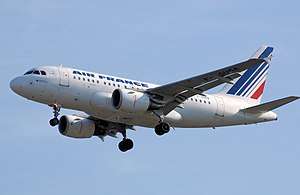 | |
| An Airbus A318 of Air France, the largest operator of the type | |
| Role | Narrow-body jet airliner |
| National origin | Multi-national[lower-alpha 1] |
| Manufacturer | Airbus |
| First flight | 15 January 2002 |
| Introduction | 2003 with Frontier Airlines |
| Status | In service |
| Primary users | Air France Avianca Brasil Avianca TAROM |
| Produced | 2001–2013 |
| Number built | 80[1] |
| Unit cost |
US$77.4 million, €63 million (2018)[2] |
| Developed from | Airbus A319 |
The Airbus A318 is the smallest member of the Airbus A320 family of short- to medium-range, narrow-body, commercial passenger twin-engine jet airliners manufactured by Airbus.[lower-alpha 2] The A318 carries up to 132 passengers and has a maximum range of 3,100 nmi (5,700 km; 3,600 mi).[3] Final assembly of the aircraft took place in Hamburg, Germany. It is intended primarily for short-range service, although British Airways uses the aircraft on a London City Airport to New York-JFK Airport transatlantic route (albeit with a stopover in Shannon for refueling on the westbound leg).
The aircraft shares a common type rating with all other Airbus A320 family variants, allowing existing A320 family pilots to fly the aircraft without the need for further training. It is the largest commercial aircraft certified by the European Aviation Safety Agency for steep approach operations, allowing flights at airports such as London City.[4]
The A318 entered service in July 2003 with Frontier Airlines. Relative to other Airbus A320 family variants, it has sold in only small numbers with total orders for 80 aircraft placed, with the order book currently being empty.[1]
Development
Background
The first member of the A320 aircraft family was the A320, which first flew on 22 February 1987 after the program was launched in March 1984.[5] The family was soon extended to include the stretched A321 (first delivery 1994), the shortened A319 (first delivery 1996), and the further shortened A318 (first delivery 2003). The A320 family pioneered the use in commercial aircraft of digital fly-by-wire flight control systems, as well as side stick controls.
The Airbus A318 project had its origins in the collaboration among Chinese, Singaporean and European manufacturers. In May 1997, during the visit of French President Jacques Chirac to China, Aviation Industries of China (AVIC), Singapore Technologies Aerospace (STAe), Airbus and Alenia signed a framework agreement that outlined the development of aircraft in the 100-seat range.[6] The AE31X programme, as it was tentatively dubbed, besides being a global industrial programme and was would have significantly deepened Sino-European commercial ties.[7]:24 With development costs estimated to be upwards of $2 billion, AVIC would have a 46 percent stake in the project, STAe 15 percent, and Airbus Industrie Asia 39 percent, the latter of which comprised Airbus and Alenia.[7]:24 Final assembly would have taken place in China.[8]
The project never went past the exploratory phase.[9]:56 It comprised two clean-sheet designs – the AE316 and the AE317. The AE316 would have had a length of 31.3 metres (102 ft 8 in), and the AE317, 34.5 metres (113 ft 2 in) .[10]:39 The standard versions of both variants had a maximum take-off weight of 49.9 t (110,000 lb) for the smaller version and 54.2 t (119,000 lb) for the AE317, and would have been powered by either BMW Rolls-Royce, CFM International, or Pratt & Whitney turbofan engines.[8][10]:39 Range was settled at 3,700 kilometres (2,000 nmi) for both standard variants, although there was a higher-gross weight version which had greater range and engine power.[10]:39 The AE316 and AE317 would have seated a maximum of 105 and 125 passengers in five-abreast seating, respectively. Both would share a flight deck and fly-by-wire flight control system similar to that of the A320 family.[6]
Market research conducting during 1997 revealed that airlines wanted a smaller aircraft in the 70-80-seat range.[11] As the project proceeded, there were increasing disagreements between the Chinese side and Airbus. China wanted a larger aircraft than originally envisioned. In addition, there were difficulties arising out of negotiations about technology transfer and production workshare, and a weak business case.[9]:56 STAe, having previously expressed doubts about returns on the project,[12] in 1998 withdrew from the project out of the failure between AIA and AVIC to reach an agreement; Airbus and AVIC would cancel the project in July that year.[13] The A318 is believed to have emerged from the AE31X project[14] though an Airbus-only project, named the A319M5 in 1995, began before the AE31X cancellation.[15]
Design phase
The internal corporate designation, A319M5, was used as early as March 1995, as an A319 derivative with fuselage shortening of 0.79 metres (2 ft 7 in) ahead of the wing and 1.6 metres (5 ft 3 in) behind.[15] The final proposal was for an aircraft seating 107 passengers in a two-class layout with a range of 3,350 kilometres (1,810 nmi). The aircraft's production took advantage of laser welding, eliminating the necessity for heavy rivets and bolts.
During the design process, the A318 encountered several problems. The first one was the decline in demand for new aircraft following the September 11 attacks. Another was the new Pratt & Whitney turbofan engines, which burned more fuel than expected; by the time CFM International (CFM) had a more efficient engine ready for market, many A318 customers had already backed out, including Air China and British Airways. America West Airlines, which had selected the Pratt & Whitney engines, amended its A318 orders, opting instead for A319 or A320 aircraft. Trans World Airlines cancelled a significant order for fifty A318s after being acquired by American Airlines, which did not operate any A320 family aircraft at the time (although neither did TWA when the order was originally placed). While Airbus was hoping to market the A318 as a regional jet alternative, laws in both the U.S. and Europe have kept it in the same class as larger aircraft for calculating charges such as landing fees, limiting the type's market potential.
The aircraft is powered by two CFM56-5 or Pratt & Whitney PW6000 engines with maximum thrust ratings of between 96 and 106 kilonewtons (21,600 and 23,800 lbf). Launch customers Frontier Airlines and Air France took deliveries in 2003, with Frontier receiving its aircraft in July of that year. The list price of an A318 ranges from $56 to $62 million, and operating costs are between $2,500 and $3,000 for each flight hour.[16]
Orders for the A318 have been relatively slow, but slightly better than for its direct competitor the Boeing 737–600. At 30 September 2017, Airbus had received 80 orders for this model[1] compared to 69 for the 737-600.[17] The sales pace has been influenced by the strong sales of the Bombardier CRJ900 and Embraer E-Jets series. The biggest A318 customers at 30 September 2017 were Governments, Executive and Private Jets (20), Air France (18), LATAM Airlines Group (15), GECAS (12) and Frontier Airlines (9).[1]
Further developments
On 10 November 2005 Airbus announced the A318 Elite. The Airbus A318 Elite is aimed at the medium-range market for flights of up to 4,000-nautical-mile (7,400 km) range, with a choice of two cabin layouts seating up to 18 passengers, and powered by CFM engines. Comlux Aviation became the launch customer by ordering three A318 Elite aircraft.
In September 2010, Airbus confirmed that from 2013 the Airbus A318 would become available with Sharklets, wingtip devices which reduce lift-induced drag and improve efficiency through reduced fuel consumption.[18] The optional devices, which will also be available on other Airbus A320 family models and are manufactured by Korean Air Aerospace Division, will increase the range of the aircraft to 5,930 kilometres (3,200 nmi) – an increase of 185 kilometres (100 nmi) over a standard A318 with 107 seats in a two-class configuration.[18]
Design
The Airbus A318 is a small commercial, narrow-body (single-aisle) aircraft with a retractable tricycle landing gear and is powered by two wing pylon-mounted turbofan engines. Two suppliers provide turbofan engines for the A318, CFM International with the CFM56-5B engine and Pratt & Whitney with the PW6000 engine. It is a low-wing cantilever monoplane with a conventional tail unit having a single vertical stabilizer and rudder.
Overall, the A318 is over six metres shorter and around 3 t (6,600 lb) lighter than the A320. To compensate for the reduced moment arm, it has a larger vertical stabiliser. While initial concepts depicted the aircraft with a Boeing 737-300-style dorsal fin extension,[19] the final design incorporated a fin tip extension, making it 75 centimetres (30 in) taller than the other A320 variants. Pilots who are trained on the other variants may fly the A318 with no further certification, since it features a common flight deck and the same type rating as its sister aircraft. The A318 is also referred to as the A318-100[20]
The A318 is available with a variety of different maximum take-off weights (MTOW) ranging from a 59 tonnes (58 long tons; 65 short tons), 2,750 kilometres (1,480 nmi) base model to a 68 tonnes (67 long tons; 75 short tons), 6,000 kilometres (3,200 nmi) version. When equipped with CFM56-5B8/P engines, the A318 is available with a 123,000 lb. MTOW or a 150,000 lb. MTOW. When equipped with CFM56-5B9/P engines, the A318 is available with a 130,000 lb. MTOW or a 150,000 lb. MTOW.[21] The lower MTOW enables it to operate regional routes economically while sacrificing range and the higher MTOW allows it to complement other members of the A320 family on marginal routes. The lighter weight of the A318 gives it an operating range 10% greater than the A320, allowing it to serve some routes that the A320 would be unable to: London – New York, Perth–Auckland and Singapore–Tokyo, for instance. Its main use for airlines, however, is on short, low-density hops between medium-sized cities.
Steep approach capability
_Airbus_A318_at_London_City_Airport.jpg)
In March 2006, the European Aviation Safety Agency (EASA) certified a modified control software enhancement to the Airbus A318 designed to allow the aircraft to perform steep approaches.[22] The aircraft is the largest commercial aircraft certified by EASA for steep approach operations.[4] The software modifies the control laws of the aircraft when the steep approach function is selected by the crew, by automatically deploying some of the spoiler panels to provide additional drag when the aircraft is in the landing configuration.[22] It also provides alternative aural alerts to the crew and modifies spoiler deployment automatically below 120 feet (37 m) on landing.[22] The A318 steep approach procedure allows the aircraft to perform approaches at descent angles of up to 5.5°, as opposed to the standard 3° for a normal approach.[4]
A test flight was conducted in May 2006 to prove the aircraft's steep approach and short runway performance by landing at London City Airport, where such steep approaches are required. The test flight also confirmed the aircraft's compatibility with the limited manoeuvring and parking space at that airport.[22] Subsequently, in August 2009[23] Airbus delivered the first A318 with steep approach capability to British Airways, which began operating the route the following month, eventually having two such aircraft capable of flights between London City Airport and John F. Kennedy International Airport in New York. On the westbound leg from London, a stopover is necessary for refueling, which occurs at Shannon Airport, Ireland because weight restrictions are necessary in order to take off within the existing short runway length of London City Airport. On the eastbound leg from New York this limitation is not present and the aircraft can take all the fuel needed for the transatlantic route to London. As of November 2017, only one aircraft is serving the route, operated in a 32-seat all-business-class configuration.[24]
Operational history
Although final assembly of A320 family aircraft takes place in Toulouse, France; Hamburg, Germany; Tianjin, China; and Mobile, Alabama, USA, final assembly of the Airbus A318 was in Hamburg, Germany.[25] The maiden flight of the Airbus A318 took place from Finkenwerder airfield in Hamburg on 15 January 2002.[26] The first customer delivery was on 22 July 2003 to Frontier Airlines.[27] As of 30 September 2017, 67 A318s remained in service with five airlines, in addition to governments, executive and private jets and undisclosed operators.[1] Most A318 aircraft retired from airline service have been scrapped due to the engine and components being more valuable than whole aircraft. Frontier Airlines, the launch customer that acquired A318 aircraft between 2003 and 2007, retired their last A318 by 2013.[28]
Operators
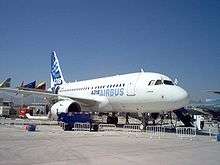
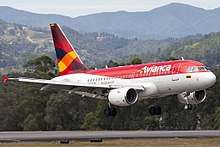
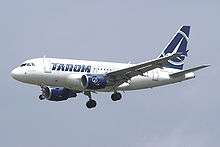
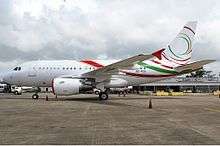
As of 30 June 2018, Airbus A318 operators are:[1]
| Country | Operator | In Operation |
|---|---|---|
| France | Air France | 18 |
| Brazil | Avianca Brasil | 10 |
| Colombia | Avianca | 10 |
| Romania | TAROM | 4 |
| United Kingdom | British Airways | 1 |
| United Kingdom | Titan Airways | 1 |
| various | Governments, Executive and Private Jets | 19 |
| various | Undisclosed operators | 4 |
| Totals | 67 |
Orders and deliveries
| Orders | Deliveries | |||||||||||||||||
|---|---|---|---|---|---|---|---|---|---|---|---|---|---|---|---|---|---|---|
| Type | Total | Backlog | Total | 2017 | 2016 | 2015 | 2014 | 2013 | 2012 | 2011 | 2010 | 2009 | 2008 | 2007 | 2006 | 2005 | 2004 | 2003 |
| A318 | 80 | — | 80 | — | — | — | — | 1 | 3 | 2 | 2 | 6 | 13 | 17 | 8 | 9 | 10 | 9 |
Data through end of September 2017. Updated 7 October 2017.[1]
Specifications
| Cockpit crew | Two | |||
|---|---|---|---|---|
| Exit Limit | 136[29][30] | |||
| 1-class max. seating[31] | 132 at 29–30 in (74–76 cm) pitch | |||
| 1-class, typical[31] | 117 at 32 in (81 cm) pitch | |||
| 2-class, typical[31] | 107 (8F @ 38 in, 99Y @ 32 in) | |||
| Cargo capacity | 21.2 m3 (750 cu ft) | |||
| Length | 31.44 m (103 ft 2 in) | |||
| Wingspan | 34.10 m (111 ft 11 in) | |||
| Wing area | 122.4 m2 (1,318 sq ft)[32] | |||
| Wing sweepback | 25 degrees[32] | |||
| Tail height | 12.56 m (41 ft 2 in) | |||
| Cabin width | 3.70 m (12 ft 2 in) | |||
| Fuselage width | 3.95 m (13 ft 0 in) | |||
| Operating empty weight | 39,500 kg (87,100 lb)[31] | |||
| Maximum zero-fuel weight (MZFW) | 54,500 kg (120,200 lb) | |||
| Maximum landing weight (MLW) | 57,500 kg (126,800 lb) | |||
| Maximum take-off weight (MTOW) | 68,000 kg (150,000 lb) | |||
| Cruising speed | Mach 0.78 (829 km/h; 515 mph)[33] | |||
| Maximum speed | Mach 0.82 (871 km/h; 541 mph) | |||
| Range, typical payload[lower-alpha 3] | 3,100 nmi, 5,750 km | |||
| ACJ range | 4,200 nmi, 7,800 km[34] | |||
| Takeoff (MTOW, SL, ISA) | 1,780 m (5,840 ft)[34] | |||
| Landing (MLW, SL, ISA) | 1,230 m (4,040 ft)[34] | |||
| Fuel capacity | 24,210 L (5,330 imp gal; 6,400 US gal) | |||
| Ceiling | 39,100–41,000 ft (11,900–12,500 m)[29] | |||
| Engines (×2) | CFM56-5B, 68.3 in (1.73 m) fan PW6000A, 56.5 in (1.44 m) fan | |||
| Thrust (×2) | 96–106 kN (22,000–24,000 lbf) | |||
Engines
| Aircraft Model | Certification Date | Engines |
|---|---|---|
| A318-111 | 23 May 2003 | CFM56-5B8/P |
| A318-112 | 23 May 2003 | CFM56-5B9/P |
| A318-121 | 21 December 2005 | PW6122A |
| A318-122 | 21 December 2005 | PW6124A |
See also
Related development
Aircraft of comparable role, configuration and era
- Antonov An-158
- Avro RJ100
- Boeing 717
- Boeing 737-600
- Bombardier CRJ700 series
- Embraer 195
- Sukhoi Superjet 100
- Tupolev Tu-334
- Yakovlev Yak-42
Related lists
References
- Footnotes
- ↑ The Airbus A318 is built in Hamburg, Germany
- ↑ Airbus was originally a consortium of European aerospace companies named, Airbus Industrie, and is now fully owned by Airbus, originally named EADS. Airbus' name has been Airbus SAS since 2001.
- ↑ Passengers and bags
- References
- 1 2 3 4 5 6 7 "Airbus Orders & Deliveries". Airbus. 30 September 2017. Retrieved 7 October 2017.
- ↑ "Airbus 2018 Price List Press Release". Airbus (Press release). 23 January 2018. Retrieved 23 January 2018.
- 1 2 "A318 Dimensions & key data". Airbus.
- 1 2 3 "Steep approach". airbus.com. Archived from the original on 17 January 2013. Retrieved 1 April 2015.
- ↑ Norris & Wagner 1999, p. 50
- 1 2 Condom, Pierre; Sutton, Oliver (1 June 1997). "New family members mean Airbus means business". Interavia Business & Technology. Retrieved 15 July 2017 – via HighBeam Research. (Subscription required (help)).
- 1 2 Sparaco, Pierre (26 May 1997). "Airbus, Asians Plan Regional Twinjet". Aviation Week & Space Technology. New York: McGraw-Hill. 146 (22): 24–25.
- 1 2 Norris & Wagner 1999, p. 87
- 1 2 Sparaco, Pierre (13 July 1998). "Europeans, Chinese Terminate AE31X". Aviation Week & Space Technology. New York: McGraw-Hill. 149 (2): 56–7.
- 1 2 3 Lewis, Paul (5–11 November 1997). "Time out in Asia". Flight International. London, UK: Reed Business Information. pp. 38–40. Retrieved 26 February 2011.
- ↑ Mecham, Michael (20 October 1997). "Market Tells Asia-Airbus Partners to Make Smaller Jet". Aviation Week & Space Technology: 63.
- ↑ Lewis, Paul (10–16 September 1997). "STAe thinks again on AE31X". Flight International. London, UK: Reed Business Information. 152 (4591): 10.
- ↑ Moxon, Julian; Lewis, Paul (8 July 1998). "Airbus Industrie and AVIC abandon AE31X". Flightglobal. Retrieved 23 April 2017.
- ↑ Eriksson, Soren (2015). The Global Commercial Aviation Industry. Routledge. p. 291. ISBN 978-1136672392.
- 1 2 Gunston 2009, p. 222
- ↑ New Bizjets Archived 4 May 2008 at the Wayback Machine. Ainonline
- ↑ "Boeing 737 Model Summary". boeing.com. 30 September 2017. Retrieved 7 October 2017.
- 1 2 Ostrower, Jon (23 September 2010). "A318 to be available with sharklets from 2013". Flightglobal. Archived from the original on 25 September 2010. Retrieved 1 April 2015.
- ↑ Kingsley-Jones, Max (9–15 June 1999). "Cut and Thrust". Flight International. 155 (4680): 150, 153–154. Retrieved 3 January 2016.
- ↑ https://www.britishairways.com/en-us/information/about-ba/fleet-facts/airbus-318-100 Retrieved 2017-06-29.
- ↑ https://www.faa.gov/documentLibrary/media/Advisory_Circular/AC%2036-1H%20Chg%201.pdf Retrieved 7 May 2017.
- 1 2 3 4 Learmount, David (13 May 2006). "Airbus A318 makes first test arrival and departure at London City Airport". Flightglobal. Archived from the original on 17 September 2007. Retrieved 1 April 2015.
- ↑ Kaminski-Morrow, David (29 August 2009). "First British Airways A318 arrives at London Gatwick". Flightglobal. Retrieved 2 May 2017.
- ↑ "Club World London City". britishairways.com.
- ↑ "Final assembly lines - Airbus, Commercial Aircraft". airbus. Archived from the original on 22 February 2017.
- ↑ "A318 takes off on maiden flight" (Press release). Airbus. Archived from the original on 8 July 2011.
- ↑ Gunston 2009, p. 223
- ↑ http://www.airlinereporter.com/2013/09/north-america-says-goodbye-to-the-babybus-airbus-a318/ Retrieved 6 May 2017.
- 1 2 "Type Certificate Data Sheet" (PDF). EASA. 28 June 2016. Archived from the original (PDF) on 15 September 2016.
- ↑ "Type Certificate Data Sheet" (PDF). FAA. August 12, 2016.
- 1 2 3 4 "All About the Airbus A320 Family". Airbus. 2009.
- 1 2 "Airbus Aircraft Data File". Civil Jet Aircraft Design. Elsevier. July 1999.
- ↑ "A320 Family Technology". Airbus.
- 1 2 3 "ACJ318". Airbus. Archived from the original on 22 January 2018.
- Bibliography
- "World Airliner Census". Flight International, Volume 184, Number 5403, 13–19 August 2013, pp. 40–58.
- Gunston, Bill (2009). Airbus: The Complete Story. Sparkford, Yeovil, Somerset, UK: Haynes Publishing. ISBN 978-1-84425-585-6.
- Norris, Guy and Mark Wagner (1999). Airbus. Osceola, Wisconsin: MBI Publishing. ISBN 978-0-7603-0677-2.
External links
| Wikimedia Commons has media related to Airbus A318. |